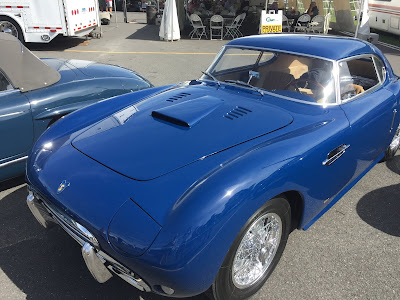A brief flashback to 1954: Early in the year Marilyn Monroe married Joe DiMaggio, the US Navy launched Nautilus, its first nuclear submarine, and President Dwight Eisenhower warned against American involvement in Vietnam, where the French garrison at Dien Bien Phu would fall in May after a 4-month siege. Sixty-five Octobers ago, film maker Elia Kazan would release "On the Waterfront", in which Marlon Brando utters the line, "I coulda been a contender"...
An episode of "The Man in High Castle" TV series prompted speculation about the mysterious convertible which appeared in one scene. One viewer speculated that the design was so exotic it might have been created just for the show. Well, except for the fact that the car is now 65 years old, it might not have been that much of a mystery. The two-seater roadster had already been immortalized in a stamp series issued by the US Postal Service in 2005, along with three of its competitors from the early 1950s...
The car was the Kaiser Darrin 161, named for its body designer and the size of its F-head Willys* engine, which was a sturdy little power plant few people noticed, as they were wowed by Howard "Dutch" Darrin's sliding doors and the curvy fiberglass body, which Kaiser-Frazer (later Kaiser Willys) claimed was the first such body to enter production. It wasn't; the 161 was beaten into production by Chevrolet's Corvette. Mighty GM had a hard time selling 300 of those in 1953, because the Corvette's price would've bought a top-line Buick with that year's new V8, and Corvette buyers had to be content with the Blue Flame 6, which wasn't a match for the Jag XK120 or any of GM's other V8s. Similarly, the 90 to 95 hp offered by the Darrin's Willys six offered 0 to 60 in 15 seconds, not exactly Jaguar performance, but for a Jaguar price of around $3,700. Other things went wrong, too...
Darrin's insistence on those tricky sliding doors led to difficult operation when the tracks got dirty, and as can be seen in the photo above, the placement and design of the door handle impinged upon an already-narrow opening. The design also precluded wind-up windows, but those weren't featured on the Corvette or the Farina-designed Nash Healey roadster either. The production 161 had a nose and fenders which pointed oddly skyward, the result of Kaiser's worries about meeting headlight height requirements. Apparently nobody at Kaiser noticed that the Porsche 356 and Jag XK120 were sold legally with lower headlight mountings...
The prototype which appeared well before the first production cars which went on sale in January 1954 had less-round wheel cutouts, along with a divided windshield and bright metal trim strips along the rocker panels. Only 435 Darrins were built from January '54 to the halt of production in August of that year. There were also 6 prototypes, and about 50 cars were damaged when a big snow storm caught them outside the plant. Howard Darrin bought the damaged cars at a steep discount, and mounted superchargers on some and Cadillac V8s in others*. This improved performance as might be expected, but was likely all the Darrin chassis, based upon the 100-inch wheelbase of Kaiser's ill-fated compact Henry J, could handle. Two other cars in the postage stamp series had better fates: Studebaker's graceful, larger and much less expensive '53 Starliner offered a V8, and despite initial production difficulties, sold over 46,000 coupes and hardtops in '53. Nash sold over 402 of its Pinin Farina styled Nash Healey* from '52 to '54, and 104 of the British-bodied '51 model, and that has to count as a success, considering prices ranging from $4,700 for the PF roadsters to $5,900 for the coupes. Ford's V8 T-Bird was heading for this market niche in 1955, and with prices starting just under $3k, Ford would sell over 16,000 copies in that first year.
This highlights the dilemma faced by Kaiser's Darrin all along. It was a Hail Mary pass meant to revive Kaiser's fortunes after Henry Kaiser made the mistake of pushing ahead with the compact, bare-bones Henry J instead of producing the V8 his engineers had designed, despite Kaiser's high production costs, which meant the firm could only make money on middle-to-upper bracket cars. Kaiser merged with Willys* during this period, and the demand for Jeeps kept their production lines busy through the 1960s. The Darrin two-seater might have been a contender with the right ratio of performance to price. Instead, it now makes for an intriguing footnote to the growth of the sports car movement in the Fifties.
*Errata:
Though historian Richard Langworth and Wikipedia claim several Kaiser Darrins got Cadillac engines, the Kaiser Frazer Owners Club confims only one, which went to Mrs. Briggs Cunningham, who raced it a few times.
*Footnote:
The Nash Healey saga is recounted in "Italian Jobs from the Heartland, Part 1", posted Nov. 17, 2016. The Willys Aero story, including some notes on the F-head engine, appears in "Willys Aero Saga: An Afterlife in Rio", our post for August 29, 2019.
Photo Credits:
Top: movies.stackexchange.com
2nd thru 5th: US Postal Service
6th: the author
7th & 8th: Kaiser-Frazer Corporation
Bottom: barrett-jackson.com









































